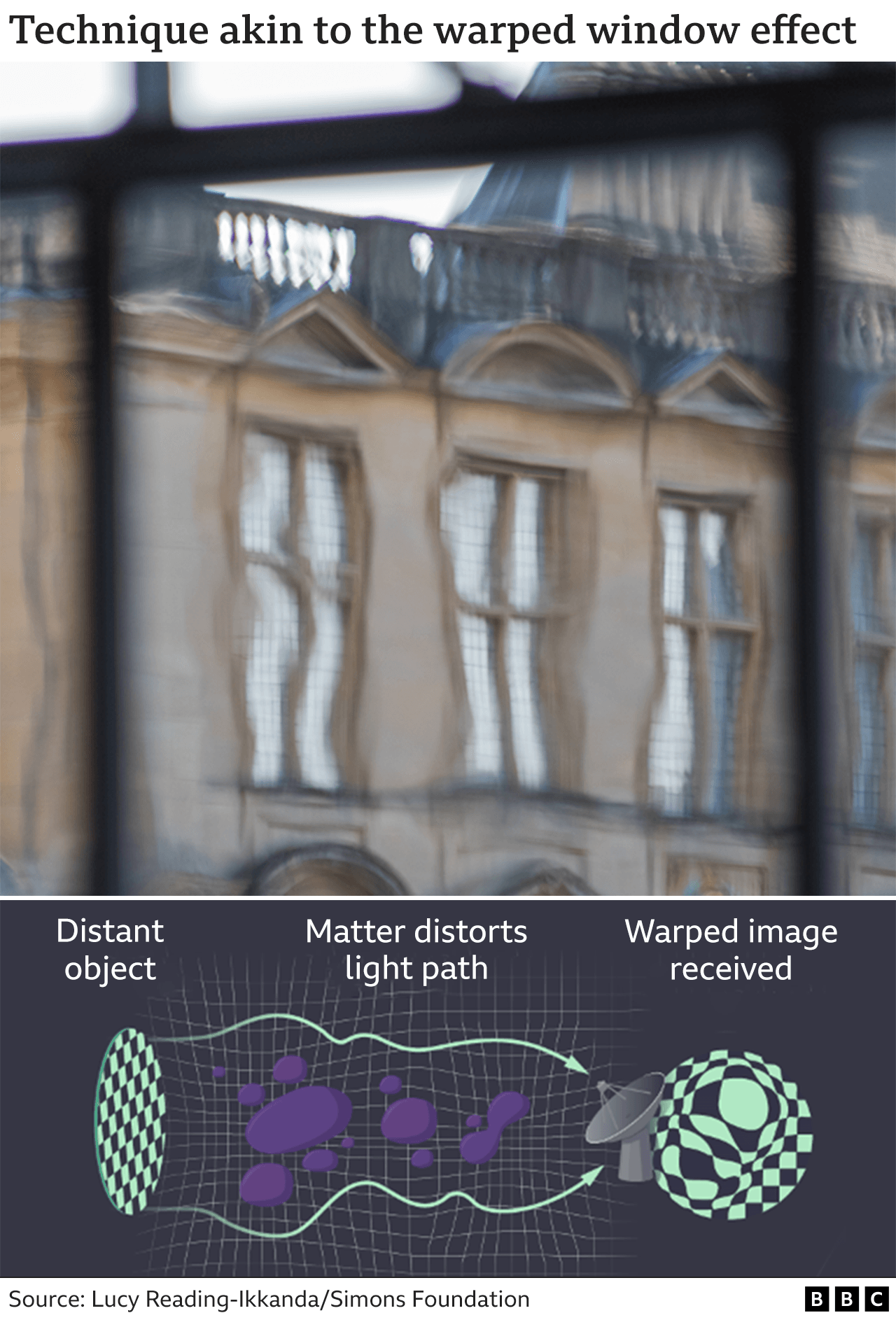13.04.2023

In the areas mapped, more matter is coloured orange; less matter is coloured magenta
It's being described as the most detailed ever map of the influence of dark matter through cosmic history.
A telescope in Chile has traced the distribution of this mysterious stuff on a quarter of the sky and across almost 14 billion years of time.
The result is once again a spectacular confirmation of Einstein's ideas.
Although dark matter makes up about 85% of all mass in the Universe, it's extremely difficult to detect and defies a ready description.
But dark matter influences the large scale structure of everything we see - where all the galaxies are, where the voids in space are. It's the scaffolding on which the visible structure of the Universe is hung.
It neither emits nor absorbs light. The only way you can very obviously infer its presence is through its interplay with gravity.
Big rotating galaxies of stars would fly apart were it not for the inclusion of some unseen mass pulling on them and keeping them intact.
But dark matter will bend, or lens, background light, and this is how its whereabouts was mapped by the Atacama Cosmology Telescope (ACT).
The Chile facility observed the Cosmic Microwave Background, or CMB - a pervasive but faint glow of long-wavelength radiation that comes to us from the very edge of the observable Universe.
ACT mapped the subtle distortions in this ancient light that were introduced as it passed by all intervening matter.
You can liken it to the way light is bent as it passes through the bulges and bumps of in an old glass window pane.
If you know what you're looking at outside, you can use the distortions to say something about the glass.
In the same way, the CMB can be decoded to reveal all intervening structure on its journey to us.
There have been "gravitational lensing" detections similar to this in the past, most notably by the European Space Agency's Planck observatory a decade ago. But ACT surpasses all in terms of resolution and sensitivity.
Composition of the Universe
Successive experiments indicate the cosmic contents include:
- roughly 5% normal matter - atoms, the stuff from which we are all made
- about 27% dark matter - so far unseen directly and defying description
- around 68% dark energy - the mysterious component accelerating cosmic expansion
The Universe is calculated to be 13.8 billion years old
In the image at the top of this page, the coloured areas are the portions of the sky studied by the telescope.
Orange regions show where there is more mass, or matter, along the line of sight; purple where there is less. Typical features are hundreds of millions of light-years across.
The grey/white areas show where contaminating light from dust in our Milky Way galaxy has obscured a deeper view.
The distribution of matter agrees very well with scientific predictions.
ACT observations indicate that the "lumpiness" of the Universe and the rate at which it has been expanding after 14 billion years of evolution are just what you'd expect from the standard model of cosmology, which has Einstein's theory of gravity (general relativity) at its foundation.
Recent measurements that used an alternative background light, one emitted from stars in galaxies rather than the CMB, had suggested the Universe lacked sufficient lumpiness.
"It's one of the 'cosmic tensions' we all talk about," said Prof Jo Dunkley from Princeton University, US. "But with this new result, we find exactly the right amount of lumpiness - no tension! So, if there is a tension, it is something that appears in the galaxy data - not in ours," she told BBC News.

Another tension concerns the rate at which the Universe is expanding - a number called the Hubble constant.
When Planck looked at temperature fluctuations across the CMB, it determined the rate to be about 67 kilometres per second per megaparsec (A megaparsec is 3.26 million light-years).
Or put another way - the expansion increases by 67km per second for every 3.26 million light-years we look further out into space.
A tension arises because measurements of the expansion in the nearby Universe, made using the recession from us of variable stars, clocks in at about 73km/s per megaparsec.
It's a difference that can't easily be explained.
ACT, employing its lensing technique to nail down the expansion rate, outputs a number similar to Planck's. "It's very close - about 68km/s per megaparsec," said Dr Mathew Madhavacheril from the the University of Pennsylvania.
ACT team-member Prof Blake Sherwin from Cambridge University, UK, added: "We and Planck and several other probes are coming in on the lower side. Obviously, you could have a scenario where both the measurements are right and there's some new physics that explains the discrepancy. But we're using independent techniques, and I think we're now starting to close the loophole where we could all be riding this new physics and one of the measurements has to be wrong."
Papers describing the new results have been submitted to The Astrophysical Journal and posted on the ACT website.
The telescope, which worked from 2007 to 2022 before being dismantled, was funded by the US National Science Foundation. The scientific collaboration has yet to finish analysing all its data.
Quelle: BBC
